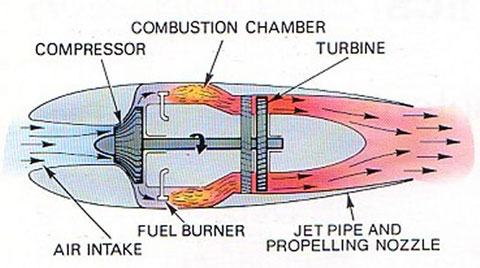Main menu
You are here
How jet engines work (turbofan animation )
How jet engines work - turbofan animation

The video
This is an animation of a duel spool, high bypass turbofan commercial jet engine..
Jet engines move the airplane forward with a great force that is produced by a tremendous thrust and causes the plane to fly very fast.
All jet engines, which are also called gas turbines, work on the same principle. The engine sucks air in at the front with a fan. A compressor raises the pressure of the air. The compressor is made up of fans with many blades and attached to a shaft. The blades compress the air. The compressed air is then sprayed with fuel and an electric spark lights the mixture. The burning gases expand and blast out through the nozzle, at the back of the engine. As the jets of gas shoot backward, the engine and the aircraft are thrust forward.
The air goes through the core of the engine as well as around the core. This causes some of the air to be very hot and some to be cooler. The cooler air then mixes with the hot air at the engine exit area.
A jet engine operates on the application of Sir Isaac Newton's third law of physics: for every action there is an equal and opposite reaction. This is called thrust. This law is demonstrated in simple terms by releasing an inflated balloon and watching the escaping air propel the balloon in the opposite direction. In the basic turbojet engine, air enters the front intake and is compressed, then forced into combustion chambers where fuel is sprayed into it and the mixture is ignited. Gases which form expand rapidly and are exhausted through the rear of the combustion chambers. These gases exert equal force in all directions, providing forward thrust as they escape to the rear. As the gases leave the engine, they pass through a fan-like set of blades (turbine) which rotates the turbine shaft. This shaft, in turn, rotates the compressor, thereby bringing in a fresh supply of air through the intake. Engine thrust may be increased by the addition of an afterburner section in which extra fuel is sprayed into the exhausting gases which burn to give the added thrust. At approximately 400 mph, one pound of thrust equals one horsepower, but at higher speeds this ratio increases and a pound of thrust is greater than one horsepower. At speeds of less than 400 mph, this ratio decreases.
In a turboprop engine, the exhaust gases are also used to rotate a propeller attached to the turbine shaft for increased fuel economy at lower altitudes. A turbofan engine incorporates a fan to produce additional thrust, supplementing that created by the basic turbojet engine, for greater efficiency at high altitudes. The advantages of jet engines over piston engines include lighter weight with greater power, simpler construction and maintenance with fewer moving parts, and efficient operation with cheaper fuel.

